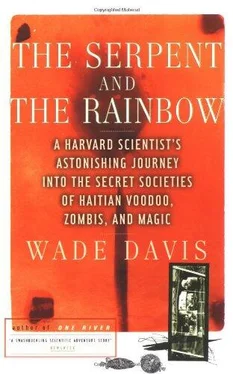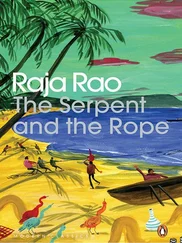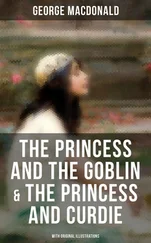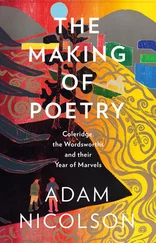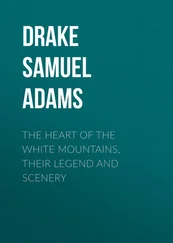Wade Davis - The Serpent and the Rainbow
Здесь есть возможность читать онлайн «Wade Davis - The Serpent and the Rainbow» весь текст электронной книги совершенно бесплатно (целиком полную версию без сокращений). В некоторых случаях можно слушать аудио, скачать через торрент в формате fb2 и присутствует краткое содержание. Год выпуска: 1985, Издательство: Simon & Schuster, Жанр: Старинная литература, на английском языке. Описание произведения, (предисловие) а так же отзывы посетителей доступны на портале библиотеки ЛибКат.
- Название:The Serpent and the Rainbow
- Автор:
- Издательство:Simon & Schuster
- Жанр:
- Год:1985
- ISBN:нет данных
- Рейтинг книги:5 / 5. Голосов: 1
-
Избранное:Добавить в избранное
- Отзывы:
-
Ваша оценка:
- 100
- 1
- 2
- 3
- 4
- 5
The Serpent and the Rainbow: краткое содержание, описание и аннотация
Предлагаем к чтению аннотацию, описание, краткое содержание или предисловие (зависит от того, что написал сам автор книги «The Serpent and the Rainbow»). Если вы не нашли необходимую информацию о книге — напишите в комментариях, мы постараемся отыскать её.
The Serpent and the Rainbow — читать онлайн бесплатно полную книгу (весь текст) целиком
Ниже представлен текст книги, разбитый по страницам. Система сохранения места последней прочитанной страницы, позволяет с удобством читать онлайн бесплатно книгу «The Serpent and the Rainbow», без необходимости каждый раз заново искать на чём Вы остановились. Поставьте закладку, и сможете в любой момент перейти на страницу, на которой закончили чтение.
Интервал:
Закладка:
Our destination was a construction camp at Santa Fe, which in those years marked the eastern limit of the right-of-way of the Pan-American Highway. A passage that should have taken two days at most stretched on to seven.
When one is lost it is not the absolute number of days that is important, it is the vast uncertainty that consumes every moment. With the rifles we had food, but it never seemed enough, and with the rains each afternoon and night we found little rest. Yet we still had to walk long hours each day through the rain forest, and when one is stripped of all that protects one from nature, the rain forest is an awesome place. Sebastian’s injury had not improved, and though he walked courageously he nevertheless slowed our progress. The heat and incessant life seemed to close in, exquisitely beautiful creatures became a plague, and even the shadows of the vegetation, the infinite forms, shapes and textures, became threatening. In the damp evenings, sitting awake for long hours while the torrential rains turned the earth to mud, I began to feel like a crystal of sugar on the tongue of a beast, impatiently awaiting dissolution.
The worst moment came on the morning of the seventh day. An hour from our previous night’s camp, we stumbled upon the first person we had seen since leaving Yavisa, a solitary and slightly mad woodsman who had carved a clearing from the forest and begun to plant a garden. When we asked the direction to Santa Fe, he looked surprised and, unable to suppress his laughter, he pointed to a barely discernible trail. At a fast pace, he told us, there was a chance that we could arrive in another two weeks. His news was so devastating that it was simply impossible to acknowledge. We had no food left, were physically and mentally exhausted, and had only enough ammunition left to hunt for two or three days. Yet we had no choice but to continue, and without a word passing between us we began to walk, myself in front with one of the rifles, then Sebastian, followed by the three Kuna. We kept a fast pace until the forest again held us tangibly, drawing us on into a hallucinatory passage devoid of will or desire. Into that trance, not twenty meters before me, leapt a black jaguar. It paused for an instant, then turned away and took several strides toward what would turn out to be the direction to Santa Fe, before springing like a shadow into the vegetation. No one else saw it, but for me it was life itself and, I believe, a portent, for it turned out that Santa Fe was not two weeks away, but rather a mere two days. That very evening, we found a track that led to the right-of-way of the highway. It had all been a test of will, and as we burst into the full sunlight after so many days in the shade, Sebastian turned to me, placed his arms about my etiolated body, and said simply that God works in mysterious ways. That evening we made camp by a clear stream and broiled a wild turkey that one of the Kuna had shot, and later we slept in the open under a sky full of stars. For our first night since leaving Yavisa, it did not rain.
The next morning I arose early, certain that I could reach Santa Fe in a single day. With my belly finally full and the weight of uncertainty lifted from my mind, I basked in the freedom of the open road and felt an exhilaration I had never known before. My pace increased and I left the others far behind. The road at first was no more than a track that curved hypnotically over and around every contour of the land. Several miles on, however, it rose slowly to the crest of a ridge, and suddenly from the rise I could see the right-of-way of the Pan-American Highway, a cleared and flattened corridor a hundred meters wide that reached to the horizon. Like a deer on the edge of a clearing, I instinctively fell back, momentarily confounded by so much space. Then I started to walk slowly, tentatively. My senses, which had never been so keen, took in every pulse and movement. No one was behind me, and no one in front, and the forest was reduced to the distant walls of a canyon. Never again would I sense such freedom; I was twenty and felt as if I had reached the heart of where I had dreamed to be.
Before I had left Boston that spring I had advised myself in the frontispiece of my journal to “risk discomfort and solitude for understanding.” Now it seemed I had found the means, and my chance meeting with the jaguar remained with me, an affirmation of nature’s benevolence. After the Darien Gap I began to look upon Professor Schultes’s assignments as koans, enigmatic challenges guaranteed to propel me into places beyond my imaginings. I accepted them easily, reflexively—as a plant takes water. Thus, in time, the Darien expedition was reduced to but an episode in an ethnobotanical apprenticeship that eventually took me throughout much of western South America. I earned my degree in anthropology in 1977 and, following a two-year hiatus from the tropics in northern Canada, returned to Harvard as one of Professor Schultes’s graduate students.
Schultes was far more than a catalyst of adventures. His guidance and example gave our expeditions form and substance, while ethnobotany remained the metaphor that lent them utility. He had spent thirteen years in the Amazon because he believed that the Indian knowledge of medicinal plants could offer vital new drugs for the entire world. Forty-five years ago, for example, he had been one of a handful of plant explorers to note the peculiar properties of curare, the Amazonian arrow and dart poisons. Struck by a poison dart, a monkey high in the forest canopy rapidly loses all muscular control and collapses to the forest floor; often it is the fall, not the toxin, that actually kills. Chemical analysis of these arrow poisons yielded D-tubocurarine, a powerful muscle relaxant once used in conjunction with various anesthetics in virtually all surgery. The several species that yielded curare were but a few of the eighteen hundred plants of medical potential identified by Schultes in the northwest Amazon alone. He knew that thousands more remained, elsewhere in the Amazon and around the world. It was to find these that he sent us out. And it was in this spirit that he brought me to the most important assignment of my career.
Late on a Monday afternoon early in 1982 I received a call from Schultes’s secretary. I was teaching an undergraduate course with him that semester and expected a discussion of the progress of the class. As I entered his office the venetian blinds were down, and he greeted me without looking up from his desk.
“I’ve got something for you. Could be intriguing.” He handed me the New York address of Dr. Nathan S. Kline, psychiatrist and pioneer in the field of psychopharmacology—the study of the actions of drugs on the mind. It had been Kline who with a handful of others in the 1950s rose to challenge orthodox Freudian psychiatry by suggesting that at least some mental disorders reflected chemical imbalances that could be rectified by drugs. His research led to the development of reserpine, a valuable tranquilizer derived from the Indian snakeroot, a plant that had been used in Vedic medicine for thousands of years. As a direct result of Kline’s work, the number of patients at American psychiatric institutions had declined from over half a million in the 1950s to some 120,000 today. The accomplishment had proved a two-edged sword, however, and had made Kline a controversial figure. At least one science reporter had referred to the bag ladies of New York as Kline’s babies.
Schultes moved away from his desk to take a call. When he was finished he asked me if I would be able to leave within a fortnight for the Caribbean country of Haiti.
2
“The Frontier of Death”
TWO NIGHTS LATER I was met at the front door of an East Side Manhattan apartment by a tall, strikingly handsome woman whose long hair was pulled up over her head in the manner of a Renoir model.
Читать дальшеИнтервал:
Закладка:
Похожие книги на «The Serpent and the Rainbow»
Представляем Вашему вниманию похожие книги на «The Serpent and the Rainbow» списком для выбора. Мы отобрали схожую по названию и смыслу литературу в надежде предоставить читателям больше вариантов отыскать новые, интересные, ещё непрочитанные произведения.
Обсуждение, отзывы о книге «The Serpent and the Rainbow» и просто собственные мнения читателей. Оставьте ваши комментарии, напишите, что Вы думаете о произведении, его смысле или главных героях. Укажите что конкретно понравилось, а что нет, и почему Вы так считаете.
